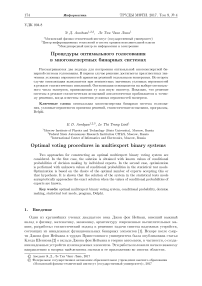Процедуры оптимального голосования в многоэкспертных бинарных системах
Автор: Аведьян Э.Д., Ле Тхи Чанг Линь
Журнал: Труды Московского физико-технического института @trudy-mipt
Рубрика: Информатика
Статья в выпуске: 4 (36) т.9, 2017 года.
Бесплатный доступ
Рассматриваются два подхода для построения оптимальной многоэкспертной би- нарной системы голосования. В первом случае решение достигается при известных зна- чениях условных вероятностей принятия решений отдельными экспертами. Во втором случае оптимизация выполняется при неизвестных значениях условных вероятностей в режиме статистических испытаний. Оптимизация основывается на выборе оптималь- ного числа экспертов, принимающих ту или иную гипотезу. Показано, что решение системы в режиме статистических испытаний асимптотически приближается к точно- му решению, когда известны значения условных вероятностей экспертов.
Оптимальная многоэкспертная бинарная система голосова- ния, условные вероятности принятия решений, статистические испытания, программы
Короткий адрес: https://sciup.org/142214997
IDR: 142214997 | УДК: 004.8
Список литературы Процедуры оптимального голосования в многоэкспертных бинарных системах
- John von Neumann. Probabilistic logics and the synthesis of reliable organisms from unreliable components//Automata Studies, Princeton University Press. 1956. P. 43-98.
- Shannon C.E. Von Neumann’s contributions to automata theory//Bull. Amer. Math. Soc. 1958. V. 64, N 3, Part 2. P. 123-129.
- Suen C.Y., Nadal C., Mai T.A., Legault R., Lam L. Recognition of totally unconstrained handwritten numerals based on the concept of multiple experts//Proc. Int. Workshop «Frontiers in Handwriting Recognition». 1990. P. 131-143.
- Hull J.J., Commike A., and Ho T.K. Multiple algorithms for handwritten character recognition//Proc. Int. Workshop «Frontiers in Handwriting Recognition». 1990. P. 117-124.
- Ho T.K., Hull J.J., and Srihari S.N. Combination of structural classifiers//Proc. I990 IAPR Workshop Syntactic and Structural Pattern Recognition. 1990. P. 123-137.
- Xu L., Krzyzak A., and Suen Ch.Y. Methods of combining multiple classifiers and their applications to handwriting recognition//IEEE Transactions on Systems, Man, and Cybernetics. 1992. V. 22, N 3. P. 418-435.
- Haykin S. Neural Networks: A Comprehensive Foundation. NY.: Macmillan College Publishing, 1994.
- Хайкин С. Нейронные сети. Полный курс. М.-СПб.-Киев: Вильямс, 2006.
- Xu L., Amari Shun-ichi. Combining classifiers and learning mixture-of-experts//Encyclopedia of Artificial Intelligence. 2009. P. 319-326.
- Ефимов Б.И., Файзуллин Р.Т. Устойчивость объективного решения экспертов при воздействии угроз по блокированию информации в системах принятия решений с привлечением экспертов//Доклады ТУСУРа. 2013. № 1(27). С. 69-77.
- Браницкий А.А., Котенко И.В. Обнаружение сетевых атак на основе комплексирования нейронных, иммунных и нейронечетких классификаторов//Информационно-управляющие системы. 2015. № 4. С. 69-77.
- Gu G., C�´rdenas A.A., Lee W. Principled reasoning and practical applications of alert fusion in intrusion detection systems//Proceedings of the 2008 ACM symposium on Information, computer and communications security. 2008. P. 136-147.
- Panda M., Patra M.R. Ensemble voting system for anomaly based network intrusion detection//International Journal of Recent Trends in Engineering and Technology. 2009. V. 2, N 5. P. 8-13.
- Wang G., Hao J., Ma J., Huang L. A new approach to intrusion detection using artificial neural networks and fuzzy clustering//Expert Systems with Applications. 2010. V. 37, I. 9. P. 6225-6232.
- Zhao H. Intrusion detection ensemble algorithm based on bagging and neighborhood rough set//International Journal of Security and Its Applications. 2013. V. 7, N 5. P. 193-204.
- Peters Ch.A. Intrusion and fraud detection using multiple machine learning algorithms//A thesis submitted to the faculty of graduate studies of the University of Manitoba, 2013.
- Chaurasia Sh., Jain A. Ensemble Neural Network and K-NN Classifiers for intrusion detection//International Journal of Computer Science and Information Technologies. 2014. V. 5. P. 2481-2485.
- Benqdara S., Ngadi A., Sharif J.M., Ali S. Ensemble of clustering algorithms for anomaly intrusion detection system//Journal of Theoretical and Applied Information Technology. 2014. V. 70, N 3. P. 425-431.
- Hock D., Kappes M. A self-learning network anomaly detection system using majority voting//Proceedings of 10th International Network Conference. 2014. P. 59-69.
- Aburomman A.A., Reaz M.B.I. A survey of intrusion detection systems based on ensemble and hybrid classifiers//Computers & Security. 2016. P. 1-45.
- Kittler J., Alkoot F.M. Sum versus vote fusion in multiple classifier systems//IEEE Transactions on Pattern Analysis and Machine Intelligence. 2003. V. 25, N 1. P. 110-115.
- Kuncheva L.I., Whitaker C.J., Shipp C.A. Limits on the majority vote accuracy in classier fusion//Pattern Analysis and Applications. 2003. V. 6. P. 22-31.
- Lam L. and Suen C.Y. Optimal combination of pattern classifiers//Pattern Recognition Letters. 1995. V. 16. P. 945-954.
- Феллер В. Введение в теорию вероятностей и ее приложения. Т. 1. М.: Мир, 1967.
- Аведьян Э.Д., Ле Т.Ч.Л. Двухуровневая система обнаружения DoS-атак и их компонентов на основе нейронных сетей СМАС//Информационные технологии. 2016. Т. 29, № 9. С. 711-718.


